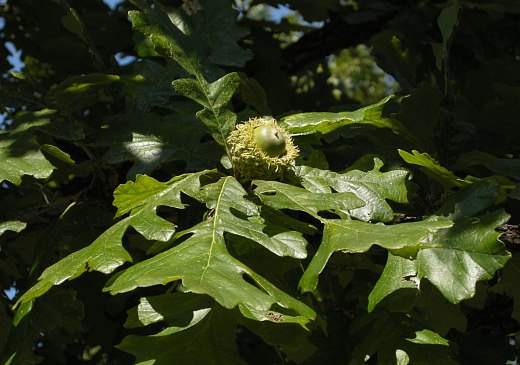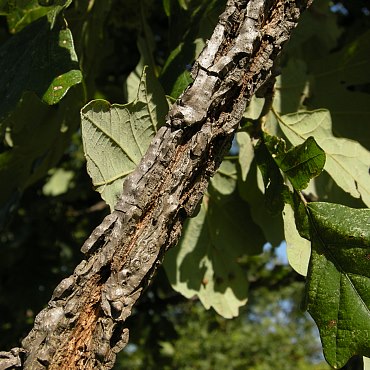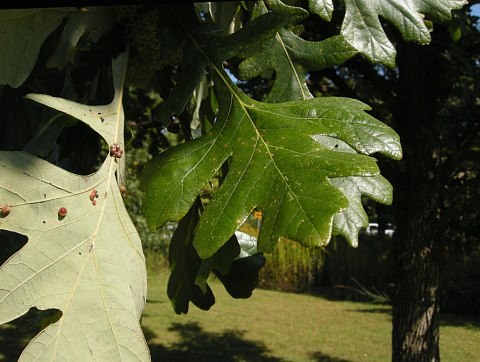Description: This tree is 80-120' tall at maturity, forming an ovoid to globoid crown with a tall stout trunk (up to 5' across). The branches of the crown are ascending to widely spreading and somewhat crooked. The thick trunk bark is gray to gray-brown with flat corky ridges and deep irregular furrows. The bark of branches and twigs is gray-brown to brown and often rather corky with flat elevated ridges. Alternate leaves about 4-10" long and 2½–5" across develop from the twigs. These leaves are obovate or broadly elliptic in outline and pinnatifid with rounded lobes. Most lobes extend moderately to deeply into the leaf blade. The deepest lobes usually occur along the lower one-half of the blade. Leaf margins are undulate and irregular, lacking any bristles or true teeth. Upper leaf surfaces are dark green and glabrous, while lower surfaces are pale gray-green and densely tomentose with short fine hairs. These hairs are often stellate or clustered together (visible with a 10x hand lens). The petioles are ½–1" long, light green, and either glabrous or tomentose.

Bur Oak is monoecious, producing both male (staminate) and female (pistillate) flowers on the same tree. The male flowers are produced in drooping yellowish catkins about 2-5" long; individual male flowers consist of a lobed calyx with 5-20 stamens. Female flowers are either solitary or clustered together in groups of 2-3. Individual female flowers (about 1/8" or 3 mm. in length) consist of a pistil that is covered with appressed scales (involucral bracts) with red styles at its tip. Overall, a female flower has the appearance of a tiny narrow cone. Both male and female flowers bloom as the leaves begin to develop during the spring. Cross-pollination is by wind. During the summer, fertile female flowers develop into nuts that are either solitary or occur in pairs. The nuts occur on short stalks up to 1" long (shorter than the petioles of the leaves); they are often nearly sessile. Nuts mature in a single year and usually germinate during the fall of the same year. Individual nuts (including their cups) are 1½–2½" long and similarly across; they are initially green, but become brown to grayish brown at maturity. The distinctive cups extend at least one-half the length of the nuts, sometimes nearly enclosing them. The coarse scales of the cups are keeled and rather knobby in appearance; the outer scales along the rim each cup have soft awns up to 1/3" (8 mm.) in length, forming a conspicuous fringe around the nut. The starchy meat of the nuts is low in tannins and potentially edible. The root system produces a deep taproot and widely spreading lateral roots. At favorable sites, this tree sometimes forms colonies.

Cultivation: Bur Oak prefers full to partial sun and loamy soil that is moist and deep. However, it is very adaptable and will tolerate more dry situations and soil that contains significant amounts of sand, clay, or gravel. Limestone-derived soil with a high pH is also tolerated. This tree is relatively slow to develop and sometimes difficult to transplant because of its deep taproot. Young saplings are relatively intolerant of flooded conditions. The nuts do not require exposure to cold winter temperature in order to germinate. An individual tree does not produce nuts until it reaches at least 30 years of age. Individual trees can live several centuries (400 years or more).
Range & Habitat: Bur Oak is a common tree that is found in every county of Illinois. Habitats include moist bottomland woodlands, upland woodlands, and savannas where deciduous trees are dominant. This tree is most commonly found in bottomland woodlands a little outside of the flood zone. It also occurs in savannas and can be an invader of prairies because of its resistance to fire. Occasionally, Bur Oak is cultivated as a landscape tree, where it can become quite large.
savannas and can be an invader of prairies because of its resistance to fire. Occasionally, Bur Oak is cultivated as a landscape tree, where it can become quite large.
Faunal Associations: The value of Bur Oak and other oak trees (Quercus spp.) to wildlife is quite high. A wide variety of insects feed on the foliage, bore through the wood, or suck the sap of these trees. This include such insects as the larvae of metallic wood-boring beetles, larvae of long-horned beetles, larvae of bark beetles, leaf beetles, weevils, larvae of gall flies, larvae of gall wasps, larvae of sawflies, aphids, leafhoppers, treehoppers, armored scales, mealybugs, plant bugs, stink bugs, walkingsticks, larvae of Duskywing skippers (Erynnis spp.), larvae of Hairstreak butterflies (Satyrium spp.), and larvae of many kinds of moths (probably several hundred). The latter group of insects includes tiger moths, ribbed coccoon-making moths, case-bearer moths, Geometer moths, leaf blotch miner moths, lappet moths, slug caterpillar moths, midget moths, owlet moths, prominent moths, giant silk moths, clear-winged moths, trumpet leaf-miner moths, and Tortrix moths (see the Beetle Table, Aphid Table, Moth Table, and Insect Table). The abundant insects that feed on oak trees attracts many insectivorous birds, including the Scarlet Tanager, Summer Tanager, Yellow-billed Cuckoo, Tufted Titmouse, Carolina Chickadee, Prothonotary Warbler, Northern Parula, Cerulean Warbler, Yellow-throated Warbler, Blue-gray Gnatcatcher, Acadian Flycatcher, Yellow-throated Vireo, and Red-eyed Vireo (Gabbe et al., 2002). Vertebrate animals use Bur Oak and other oak trees as a source of food too. Many kinds of birds eat the smaller acorns of some oak trees, although the large acorns of Bur Oak are eaten primarily by mammals. These mammals include the Gray Fox, White-tailed Deer, Prairie Vole, Meadow Vole, White-footed Mouse, Virginia Opossum, Raccoon, Southern Flying Squirrel, Eastern Gray Squirrel, Fox Squirrel, American Red Squirrel, Eastern Chipmunk, Muskat (minor), and American Black Bear. The White-tailed Deer and Elk also browse on the twigs and foliage of these trees, while the Cottontail Rabbit gnaws on the bark of saplings during the winter (Martin et al., 1951/1961; Hamerstrom & Blake, 1939; Whitaker, 1966; Beeman & Pelton, 1980; Schneider et al., 2006). Oak trees also provide protective cover for many kinds of wildlife. Many birds select these trees for nesting sites: This includes the Red-shouldered Hawk, Cerulean Warbler, Hooded Warbler (saplings), Blue-gray Gnatcatcher, Eastern Wood-pewee, Yellow-throated Vireo, and Field Sparrow (saplings); see Dijak et al. (1990), Newell & Rodewald (2011), Bielefeldt & Rosenfeld (2001), and Best (1978). The Eastern Screech Owl sometimes uses oak trees as daytime roost sites, while such bats as the Silver-haired Bat, Evening Bat, Big Brown Bat, Hoary Bat, Little Brown Bat, Tricolored Bat, Indiana Bat, and Northern Long-eared Bat use them for both daytime roost sites and locations for maternity colonies (Belthoff & Ritchison, 1990; Perry et al., 2010; Perry & Thill, 2008; Swier, 2003; Baerwald et al., 2012; Veilleux et al., 2003).

Photographic Location: Crystal Lake Park in Urbana, Illinois.
Comments: This tree has the largest acorns of any oak. Not only are the acorns large, but they have a distinctive appearance because of the conspicuous fringe along the rim of their cups. Bur Oak is a member of the White Oak group, which means that its acorns mature in a single year, its leaves lack bristles at the tips of their lobes, and it can hybridize with many other oaks within this group. In addition to its distinctive acorns, Bur Oak can be distinguished from other oaks by the corky ridges of its branches and the shape of its leaves. Generally, the leaves of Bur Oak have deeper lobes than those of many other oaks, and the deepest lobes usually occur along the lower half of the length of each leaf. Bur Oak can be distinguished from the similar White Oak (Quercus alba) by the tomentose hairs on the lower sides of its leaves; the leaves of the latter oak are hairless on their undersides.